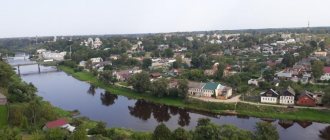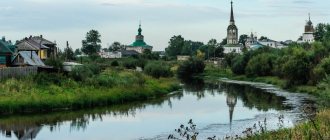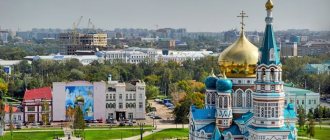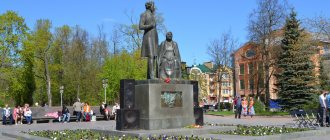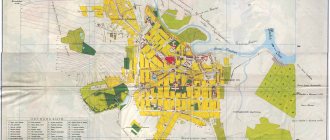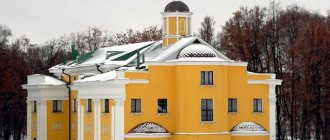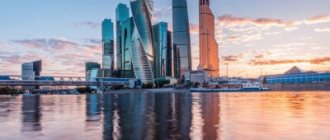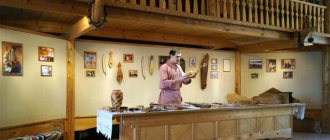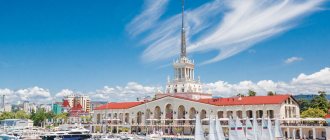Minusinsk
, a city in Russia, the administrative center of the Minusinsk region of the Krasnoyarsk Territory, the cathedral city of the Minusinsk diocese. Located on the right bank of the Yenisei channel, 661 km (by rail) south of Krasnoyarsk, 12 km from the railway station of the same name on the Abakan-Tayshet, Abakan-Achinsk lines. Highway "Yenisei" (Krasnoyarsk-Divnogorsk-Abakan-Minusinsk). Abakan-Kyzyl highway (Usinsky tract). Pier. Population: 70,111 people (2012) [1].
- On the map: Yandex.Map, Google map
History of the settlement in the 18th century
The first documentary evidence about Minusinsk was left by the bergmeister (mining master) of the imperial Berg College, Nikifor Kleopinus. In 1741, he compiled a report on the results of a survey of copper mines on the Yenisei, in which he reported on a rural settlement on the river. Minus, where former workers of the Lugazsky (Lukazsky, Lugavsky) copper smelter lived with their families. Historian G.F. Bykonya believes that the village of Minusinskaya arose earlier - in 1739-1740 with the opening of the Lugazsky (Lugavsky) copper smelter and Irbinsky ironworks.
In 1744, the copper smelter ceased to exist and was never revived, and the assigned village of Minusinskaya (Minyusinskaya) became an ordinary peasant settlement.
Since 1780 - the village of Minusinskoye, Krasnoyarsk district.
In 1794, the Zemskaya Izba was opened in Minusinsk, which was in charge of the villages on the right bank of the Yenisei to the river. Tuba.
In 1797, the village of Minusinskoye became the center of the volost; the administration from the Abakan fort, which was in charge of all settlements and affairs in the south of the Krasnoyarsk district, moved to it.
The city of Minusinsk in the XIX - early years. XX centuries
| Minusinsk. General view of the north side. Postcard con. XIX-early XX century |
In December 1822, the Yenisei province was formed, which included the Minusinsk district.
The center of the district became the village of Minusinsk, transformed into the district city of Minusinsk. After the formation of the city, the residents of Minusinsk remained peasants for some time. In 1828, they were transferred to the petty bourgeois class, which determined a different nature of their occupations - crafts, trades, etc. The main occupation of the townspeople was still arable farming and animal husbandry. In the second quarter of the 19th century, the merchant class was formed in Minusinsk. Basically, these were people from the bourgeois and peasant classes.
From the middle of the 19th century, crafts and trade began to develop, and industry began to appear. In 1865, 9 factories and factories operated in Minusinsk, incl. 4 brick factories, 3 tanneries, 2 lard factories.
The first city mayor of Minusinsk in the 1870s was elected merchant of the 1st guild, hereditary honorary citizen I.G. Gusev. All subsequent city leaders were also from the merchant class. Only in 1908 was the tradesman P.A. elected mayor. Bakhov (he was the last).
In the second half of the 19th century, Minusinsk became a major trading center in southern Siberia. Of the merchants, most traded according to the certificates of the 2nd guild, i.e. conducted domestic wholesale and retail trade, opened factories and factories, and had the right to foreign trade. The first bazaar in the city was established in 1834, at the end of the 19th century there were three of them - Sredovoy, Pyatnitsky, Saturday. In 1899, there were 176 trading establishments in the city. Minusinsk merchants traded with the Uriankhai region (Tuva), China, Mongolia, and even penetrated into Japan. They brought bread, iron, textiles, fish, cedar, nuts, furs, and Siberian handicrafts from Siberia. Since 1890, merchants G.P. Safyanov and M.I. Byakov began to import tea from China through the Uriankhai region, which was sold in Minusinsk and further to the Urals.
At the end of the 19th century, the city's industry was represented mainly by small enterprises processing agricultural products - candles, soap-making, lard-making, flour-grinding. The largest were the brewery of the tradesman I.E. Eldeshtein, winery of the Danilov brothers. In 1908, the first steam mill N.P. was built in Minusinsk. Pashennykh.
The construction of the Siberian Railway in the late 1890s and the opening of steamship traffic along the Yenisei had a noticeable impact on the commercial and industrial life of the city.
| Minusinsk. View of the central part of the city from the fire tower. Photo beginning XX century (minusinsk-uezd.livejournal.com) |
By the end of the 19th century, Minusinsk became not only a large commercial and industrial center, but also a cultural center of Siberia.
On March 5, 1850, the first educational institution was opened - a parish school. On September 9, 1880, a women's gymnasium was opened, transformed into a gymnasium in 1908 (closed in 1920). In 1913, a teacher's seminary and a secondary school were opened, 13 elementary schools (schools) and a trade school also operated. In the 1880s, an amateur theater society began to operate in Minusinsk.
In 1887, a telegraph appeared in the city. In 1888, the first printing house was opened in the city. At the beginning of the century, there were 3 cinemas in Minusinsk. The local public museum, founded in 1877 by pharmacist N.M., brought great fame to the city. Martyanov. In 1878, a public library was opened at the museum.
Minusinsk, significantly removed from the center of Russia, became convenient for the placement of political criminals. In 1827-1861. Decembrists S.G. were in a settlement in the city. Krasnokutsky, S.I. Krivtsov, brothers A.P. and P.P. Belyaevs, A.A. and N.A. Kryukovs, N.O. Mozgalevsky, I.V. Kireev. At various times, participants in the Polish uprisings of 1830-1831 and 1863-1864, exiled for long periods of time and permanently settled, lived in the city. In 1860, the famous revolutionary socialist M.V. was in exile in Minusinsk. Butashevich-Petrashevsky. In 1860-1917, populists, social democrats, Marxists, representatives of various political parties and organizations, and participants in peasant uprisings served their exile in Minusinsk: A. A. Kropotkin, D. A. Klements, P. A. Argunov, N. S. Tyutchev and others. V.I. visited Minusinsk more than 10 times. Ulyanov (Lenin). Deputies of the Second State Duma were in exile in Minusinsk. Political exiles of all generations had a huge impact on economic activity, culture, education, medicine, and on the social and political life of Minusinsk.
In 1913, construction of the railway from Achinsk to Minusinsk began, but the First World War suspended it.
During Soviet times
From July 21, 1917, the leadership of the district was carried out by the district commissioner of the Provisional Government P.N. Tarelkin. At the same time, active campaigning was carried out among the population by representatives of all political parties and groups. In September 1917, the Bolsheviks of Minusinsk began preparing an armed uprising. On November 10, the Council of Workers' and Soldiers' Deputies decided to liquidate the bodies of the old state apparatus in Minusinsk. The Red Guard occupied the post office, telegraph office, treasury and other institutions.
In June 1918, as a result of the counter-revolutionary White Czech rebellion, the first Soviet government in Siberia was eliminated. Power passed into the hands of the Provisional Siberian Government.
In September 1919, Soviet power in the city was restored by a partisan army that came to Minusinsk from Belotsarsk (now Kyzyl).
In 1924, the city of Minusinsk became the administrative center of the Minusinsk district (district) and the Minusinsk region. In 1930, the Minusinsk district was abolished. The city of Minusinsk remained the administrative center of the Minusinsk region. In 1942, the city left regional subordination and became an independent administrative unit.
And in Soviet times, Minusinsk was a place of exile. 1920-1960s, prominent state and party leader L.B. was sent to settle in Minusinsk. Kamenev, famous film actor L.L. Obolensky, sculptor G.D. Lavrov, biologist and Pushkin scholar N.A. Raevsky and others.
In 1920, work on the construction of the Achinsk-Minusinsk railway was resumed, and in November 1925 it was brought to Abakan.
In 1922, in Minusinsk there were 7 primary (1st level) schools, 1 2nd level school, 1 school of the union of cooperators, 1 Tatar school (opened with funds from Muslims in 1918, closed at the end of the 1930s).
In 1926, there were 14 industrial enterprises (272 workers). There was a power station, a telephone exchange (96 subscribers), a library, a museum, a theater, 4 clubs, 7 medical institutions, and a pharmacy.
During the Great Patriotic War of 1941-1945, Minusinsk enterprises produced products necessary for the front - felt boots, skis, sleighs, sheepskin coats, shag and food products. Minusinsk received and located hospitals and orphanages. More than 5 thousand Minusinsk residents died on the battlefields and went missing.
In the early 1960s, Minusinsk, the center of a large agricultural region, entered a new stage of its development, determined by the construction of the Abakan-Tayshet railway.
Until the 1970s, Minusinsk remained a center of predominantly agricultural production. Further industrial development of the city was associated with the creation of the Sayan territorial-industrial complex (Sayan TPK), which included the Minusinsk industrial hub.
In 1978, the production association “Minusinsk Electrotechnical Industrial Complex” (PO MEPK) was created. The Minusinsk experimental and methodological geophysical expedition was involved in scientific developments in the city.
The airport was opened in 1985.
Major sports competitions were held in Minusinsk: in 1986 - the fifth winter Spartakiad of the peoples of the USSR, in 1988 - the regional summer Spartakiad of the cities of the Krasnoyarsk Territory.
Nowadays
At the beginning of the 21st century, many enterprises and institutions that had previously operated in the city were liquidated. Industrial enterprises of the city, including enterprises of the electrical complex, changed their form of ownership and were transformed into various joint-stock companies.
The economy of modern Minusinsk is represented by enterprises in the electrical, food, light, and furniture industries; The printing house is working. Minusinsk is the center of a fertile region favorable for farming, the agricultural products of which are known far beyond its borders.
Minusinsk is included in the list of historical cities of Russia. In the vicinity of the city there are archaeological monuments: mounds, pisanitsa, fortifications.
Statistics
- 1794 - 64 households, 438 inhabitants (218 men and 220 women)
- 1863 - 1 stone church and 1 wooden chapel, 5 state (including 1 stone), 3 public and 603 private (including 1 stone) houses, 3872 inhabitants (of which 301 were merchants, 1785 - bourgeois).
- 1897 - 10231 people
- 1917 - 12807 people
- 1926 – 21427 people
- 1973 - 46.4 thousand people
- 1989 - 76 thousand people
- 2002 - 72,561 people [2]
- 2010 - 71,171 people [3]
general review
Minusinsk is the administrative center of the city district and region of the same name and belongs to the Krasnoyarsk Territory of the Russian Federation. The city is located along both banks of the Yenisei River in Eastern Siberia. The area of the city of Minusinsk is 17.7 sq. km.
The Minusinsk railway station is located at a distance of 12 kilometers, and Abakan is located relatively close (25 kilometers). The federal highway M54 “Yenisei” passes near the city. From the regional center of Krasnoyarsk to Minusinsk 422 kilometers.
The founding date is considered to be 1739, when the village of Minyusinskoye was built. The settlement got its name from the Minusa River, which means “big water” in Turkic. In 1822 it received city status.
Minusinsk is located in a time zone shifted relative to Moscow by 4 hours. In Russia it is designated as MSK+4. Krasnoyarsk and Minusinsk are in the same time zone.
How to get there, when to come and where to stay
It is best to come to Minusinsk in mid-August, when City Day is celebrated and the tomato festival is held.
The night train from Krasnoyarsk arrives in Minusinsk at about 6 o'clock in the morning. You can take the same train back at 19:00.
If you want to go overnight, I advise you to stay in Abakan, where there is a larger selection of hotels and hostels. From the capital of Khakassia to Minusinsk it is worth making a trip for the whole day; buses run there from 7 am to 10 pm.
Have you been to Minusinsk? How do you like this small Siberian city? Share your impressions with us and send your stories to the “Small Towns of Russia” section. We will publish the best on our website Dorogi-ne-dorogi.ru.
Foundation of the city
The settlement, which arose as a workers' village, turned into an ordinary peasant village after the closure of the copper smelter. The population of those times has not been established. A year after receiving city status (in 1823), there were 787 people in Minusinsk, of which 156 were exiled settlers, who for a long time constituted the second largest group of residents (after peasants).
Despite the fact that people now lived in a city that still looked like a village, the population of Minusinsk continued to engage in peasant labor. Nevertheless, in 1828, the peasants were transferred to the petty bourgeois class, which was supposed to engage in trades and crafts. But many continued to engage in farming and cattle breeding for a long time.
What to see in Minusinsk
Minusinsk Local Lore Museum named after. N. M. Martyanova
Minusinsk Museum of Local Lore / photo by the author
The oldest museum of the vast Krasnoyarsk Territory is located not in Krasnoyarsk, but in small Minusinsk. Created in 1877. It is 14 years older than the Trans-Siberian Railway. It is a rare case in Siberia that a museum in a county town appeared in the 19th century. In 1893 and 1900, his collections received awards at exhibitions in Chicago and Paris.
One of the first local history museums in the Asian part of Russia was housed in a two-story mansion built in 1890. Interestingly, in the same building there was a library, which Vladimir Lenin visited during his Siberian exile, as a memorial plaque on the facade reminds.
From the exhibition you will learn the history of the Minusinsk Basin from the moment the first people appeared in these areas. Among the exhibits on the first floor I would like to note medieval steles with runic inscriptions and reconstructed houses of local residents and khans. The exhibition on the second floor tells about the settlement of the Minusinsk region in the 18th-20th centuries by Russians, Ukrainians, Germans and representatives of other peoples.
Memorial Museum Apartment of G. M. Krzhizhanovsky
Museum Apartment of G. M. Krzhizhanovsky / photo by the author There
are only two museums in Russia dedicated to this revolutionary and scientist, the creator of the plan for the electrification of the USSR - GOELRO. The first is located in the center of Moscow, and the second opened in Minusinsk in the year of Lenin’s 100th anniversary.
The exhibition is housed in a two-story wooden mansion built in 1878. Gleb Krzhizhanovsky lived in this house for a short time, in 1898-1899. The exhibition is not as interesting and varied as in the Moscow museum. You can see household items from pre-revolutionary Russia in other places.
Decembrists Museum
Minusinsk is one of those cities in Siberia where the Decembrists were exiled in 1826.
In total, 8 people came to the settlement. They lived in this city from 1827 to 1861 and distinguished themselves in the development of agriculture in the Minusinsk Basin. The Decembrists grew watermelons, melons and fruits. Some of them opened the first school in the city. The museum opened in 1997 after lengthy preparation. The exhibition is housed in one of the oldest wooden houses in the city, which is about 200 years old.
Museum of Cars and Motor Vehicles of the USSR
A private museum, opened in 2005 by a family who moved from Norilsk. In one room there are cars from the 1930s to the 1970s, in the other there are motorcycles and bicycles. The rest of the territory is occupied by models, cars undergoing restoration and various items of Soviet everyday life. It is interesting that it operates a kind of “museum within a museum”, which tells about the history of the Usinsky tract.
Museum of Minusinsk Drama Theater
One of the oldest theaters in Siberia. Its museum is the only free one in the city. A small exhibition occupies a hall on the ground floor of the theater, founded 4 years later than the Martyanov Museum, in 1882.
Festival "Minusinsk Tomato"
Tomatoes have become the same symbol for the fertile Minusinsk Basin as watermelons are for Astrakhan. On the day of the festival you will see various folk performances, an exhibition of vintage cars near the building of the local history museum, a “tomato parade”, and a fair of local products.
The festival is held in mid-August, target the third Saturday. This is the best day to visit the city.
Historical center of Minusinsk
The historical part with pre-revolutionary buildings is located on the northern bank of the Minusa River. Conveniently, there is also a bus station there, where you can arrive by bus from Abakan and start sightseeing. Minusinsk was built up according to a plan approved in 1844. About 500 wooden and stone buildings built before 1917 have survived. Together they form the ensemble of the district Siberian city.
Spassky Cathedral
Spassky Cathedral in Minusinsk
The first stone church in the city. Built in 1813. The cathedral stands at the intersection of Komsomolskaya and Red Partisans streets, between the local history museum and the drama theater. It’s an interesting neighborhood, so it fits well into the look of the historical part of Minusinsk.
Merchant Vilner's House
Of the pre-revolutionary buildings, this example of Siberian baroque from 1909-1912 stands out. It’s a pity that it didn’t house one of the branches of the local history museum. The house is located opposite Lenin Park and the city administration.
Lenin Park
Monument to Shchetinkin / photo by the author
It is worth walking around its perimeter and not only to admire the city architecture. In the center of the park there is a monument to Ilyich wearing earflaps, large for a regional center. This version of a monument to a leader is very rare. The size can be explained by the fact that Lenin was in exile near Minusinsk at the end of the 19th century.
There is also a monument to the Siberian Red Partisans of the Civil War in the park. It was about them that in 1971 the Sverdlovsk Film Studio made the film “Nomadic Front”. These partisans were commanded by Pyotr Shchetinkin. The most famous monument to him is located across the road from the north-eastern corner of the park, between the Vilner house and the Krzhizhanovsky Museum.
Soviet Minusinsk
Entrance to Victory Park / photo by the author
This is the name of the neighborhoods on the southern bank of Minusa, buses run through them to Abakan. There are a lot of buildings from the 1960-1980s, a market, shops and cafes, a monument to Tomato and Victory Park with a memorial, a T-34 tank and a monument to children of war.
Second half of the 19th century
In 1856, the population of Minusinsk was 2,200 people, having more than tripled in two decades. At this time, the transition from peasant labor to other types of activity began. A merchant class is gradually forming in the city. The peculiarity of the local merchants was that they only lived in Minusinsk, and were engaged in trade in other cities of Siberia.
The document “List of populated places of the Yenisei province” for 1859 noted that in the district city of the Minusinsk district, located 551 versts from the provincial city of Yeniseisk, there were 372 houses in which 2,936 people lived, including 1,491 male residents gender and 1,445 female. Trade and crafts developed in the city, and the first small factories appeared. The population continued to grow rapidly, largely due to the peasants of the central Russian provinces. In 1897, the population of Minusinsk was 10,231 people.
Main streets of Minusinsk
It’s quite difficult to get lost in the city, but a map of Minusinsk with streets will help you quickly find the one you need. The main streets of the city are:
- st. Komsomolskaya. Central Street. The communal bridge across the Minusinskaya Channel divides the street in half. From the north it is Komsomolskaya, where the Minusinsk Interdistrict Hospital, the city library, and the Cathedral of the Savior Not Made by Hands are located. The southern part is Abakanskaya Street. Shopping centers and markets are concentrated here. After the Crossroads with Narodnaya Street. the dividing line turns into islands of greenery.
- st. Red partisans . It starts at the Cathedral Square with the Cathedral of the Savior Not Made by Hands and ends at the intersection with P257. On this street there is a city bus station and the buildings of the College of Culture and Arts.
- st. Vokzalnaya. Located east of the river between st. Embankment and Sotnichenko. Another Vokzalnaya street is located outside the city and runs from Koltsevaya street. to the Minusinsk railway station.
- st. Suvorov. It runs through the northern part of the city from Shtabnaya Street. (area of the Old Cemetery) and abuts the P257 highway where the forest begins.
- st. Pushkin . Starts from st. Mikhailov, ends in the private sector.
- st. Oktyabrskaya. Parallel to the street Pushkin. Coming from the street. Krylova to st. Sotnichenko (P257). On it there is a landscaped Lenin Square with a monument to him, the Alliance cinema park, and the old market.
Between two wars
The construction of new industrial enterprises, including soap factories and candle factories, contributed to the attraction of labor resources. In 1914, there were 15,000 people in the city of Minusinsk.
In the revolutionary year of 1917, the “Lists of settlements of the Yenisei province” indicate data on the total number of residents - 12,807, of which 5,669 were male and 7,138 female, including 259 military. After the end of the civil war, industry began to develop in the city . In 1926, several dozen enterprises of various forms of ownership (private, state, cooperative) operated in the settlement. For example, yeast, tobacco factory "Dynamo", which produced products worth 1.2 million rubles. At that time, the population of Minusinsk was 20,400 people.
The city still remained a place of exile; for example, the prominent revolutionary figure L.B. Kamenev was exiled here. By 1931, the number of residents decreased slightly to 19,900, which was also associated with the beginning of repression. In subsequent years, the city was actively improved, new schools, a pedagogical college, courses for nurses, machinists, state farm and forestry apprenticeships were opened. The number of inhabitants increased to 31,354 in 1939.
Second half of the 20th century
In the first years of the war, two regiments were formed in the city; more than 5,000 thousand Minusinsk residents died on the fronts of the Great Patriotic War. Some researchers believe that as a result of pre-war political repressions and taking into account the townspeople who died in the war, the population was renewed by almost 75%. According to the first post-war census in 1959, 38,318 people lived in the city.
In subsequent years, small industrial cooperatives of the post-war years were re-equipped and reconstructed into factories and furniture, shoe repair and clothing factories offered many new jobs. In 1967, the population of Minusinsk increased to 42,000 people. The development of the city is largely connected with the Minusinskneftegazrazvedka trust, which built a lot of housing and social and cultural facilities - a sports complex, the Geologist club. In 1979, the city had 56,361 inhabitants. The population increased due to the influx from the central regions of the country.
Modernity
The rapid growth of the population in the first half of the 80s was associated with the creation of the electrical complex; factories of high-voltage vacuum circuit breakers and special technological equipment were built. In 1987, the number of inhabitants reached 72,000 people. The population of Minusinsk reached its maximum (74,400 people) in 1992. In subsequent years, the number of city residents generally decreased. In post-Soviet times, the structure of the economy has changed significantly; now the population is offered jobs at a wood processing plant, agricultural industry, and small and medium-sized businesses. In 2021, the city had 68,309 residents.
Local kitchen
Minusinsk is located on historical Khakassian lands, but it is extremely difficult to find the cuisine of this people in the city. There are problems with it even in Abakan.
You can have a snack in a cafe serving Russian-Soviet or Georgian cuisine, in a pizzeria or in canteens. There are more modern establishments like Eating an Elephant , but in the historical part of the city you can come across canteens with nostalgic Soviet decoration. The city has a developed food industry. Local dishes worth trying are cheeses, canned vegetables, meats and confectionery.
Buy a puck of local cheese “Kachkaval”, which received a gold medal at an international competition.
